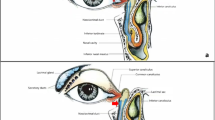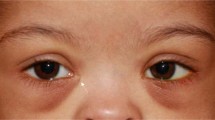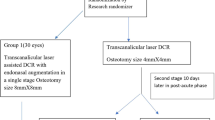Abstract
Purpose
To prospectively evaluate the surgical outcomes of membranous and solid distal common canalicular obstructions (CCOs) following endoscopic dacryocystorhinostomy (EnDCR) and lacrimal intubation combined with either membranotomy or trephination.
Methods
This was a prospective, non-randomized, consecutive interventional case series. Inclusion criteria included patients undergoing EnDCR with evidence of a membranous block or more solid obstruction of the distal common canaliculus, treated with membranotomy or canalicular trephination. Complete CCO was confirmed pre-operatively using dacryocystography and dacryoscintigraphy. All patients received bicanalicular intubation for 3 months with a minimum follow-up of 12 months. Functional and anatomical success was assessed at 4 weeks, 3 months, and 12 months following surgery. Functional success was defined as subjective improvement of epiphora and anatomical success as the presence of a patent ostium and a positive dye test on nasal endoscopy.
Results
Twenty-nine patients were included in the study with a mean age of 58 years. Twenty-one patients (72%) received a membranotomy and eight (28%) required trephination. At 12 months, the functional and anatomical success rate in the membranotomy group was 90% (19/21) and 100% (21/21), respectively, and in trephination group the functional and anatomical success rate was 63% (5/8). There were no intra-operative or lacrimal stent-related complications.
Conclusions
Identifying and excising distal CCOs in association with EnDCR and lacrimal intubation is associated with a high degree of functional (83%) and anatomical (90%) success. The success of membranous obstructions appear be superior to outcomes for solid obstructions of the distal common canaliculus that require trephination.
Similar content being viewed by others
Log in or create a free account to read this content
Gain free access to this article, as well as selected content from this journal and more on nature.com
or
References
Welham RA, Henderson PH . Results of dacryocystorhinostomy analysis of causes for failure. Trans Ophthalmol Soc UK 1973; 93 (0): 601–609.
Boboridis KG, Bunce C, Rose GE . Outcome of external dacryocystorhinostomy combined with membranectomy of a distal canalicular obstruction. Am J Ophthalmol 2005; 139 (6): 1051–1055.
Doucet TW, Hurwitz JJ . Canaliculodacryocystorhinostomy in the management of unsuccessful lacrimal surgery. Arch Ophthalmol 1982; 100 (4): 619–621.
Hwang SW, Khwarg SI, Kim JH, Choung HK, Kim NJ . Bicanalicular double silicone intubation in external dacryocystorhinostomy and canaliculoplasty for distal canalicular obstruction. Acta Ophthalmol 2009; 87 (4): 438–442.
Khoubian JF, Kikkawa DO, Gonnering RS . Trephination and silicone stent intubation for the treatment of canalicular obstruction: effect of the level of obstruction. Ophthal Plast Reconstr Surg 2006; 22 (4): 248–252.
Sisler HA, Allarakhia L . New minitrephine makes lacrimal canalicular rehabilitation an office procedure. Ophthal Plast Reconstr Surg 1990; 6 (3): 203–206.
Welham RA, Wulc AE . Management of unsuccessful lacrimal surgery. Br J Ophthalmol 1987; 71 (2): 152–157.
Yang SW, Park HY, Kikkawa DO . Ballooning canaliculoplasty after lacrimal trephination in monocanalicular and common canalicular obstruction. Jpn J Ophthalmol 2008; 52 (6): 444–449.
Nemet AY, Wilcsek G, Francis IC . Endoscopic dacryocystorhinostomy with adjunctive mitomycin C for canalicular obstruction. Orbit 2007; 26 (2): 97–100.
Chan W, Fahlbusch D, Dhillon P, Selva D . Assisted local anesthesia for powered endoscopic dacryocystorhinostomy. Orbit 2014; 33 (6): 416–420.
Andrew N, Selva D . Postoperative haemorrhage in powered endoscopic dacryocystorhinostomy. Clin Experiment Ophthalmol 2014; 42 (3): 262–265.
Figueira E, Al Abbadi Z, Malhotra R, Wilcsek G, Selva D . Frequency of simultaneous nasal procedures in endoscopic dacryocystorhinostomy. Ophthal Plast Reconstr Surg 2014; 30 (1): 40–43.
Shams PN, Selva D . Acute post-operative rhinosinusitis following endonasal dacryocystorhinostomy. Eye (London, England) 2013; 27 (10): 1130–1136.
Cannon PS, Chan W, Selva D . Incidence of canalicular closure with endonasal dacryocystorhinostomy without intubation in primary nasolacrimal duct obstruction. Ophthalmology 2013; 120 (8): 1688–1692.
Chan W, Selva D . Ostium shrinkage after endoscopic dacryocystorhinostomy. Ophthalmology 2013; 120 (8): 1693–1696.
Munk PL, Lin DT, Morris DC . Epiphora: treatment by means of dacryocystoplasty with balloon dilation of the nasolacrimal drainage apparatus. Radiology 1990; 177 (3): 687–690.
Wormald PJ . Powered endoscopic dacryocystorhinostomy. Laryngoscope 2002; 112 (1): 69–72.
Sisler HA, Allarakhia L . A new ophthalmic microtrephine. Ophthalmic Surg 1990; 21 (9): 656–657.
McLachlan DL, Shannon GM, Flanagan JC . Results of dacryocystorhinostomy: analysis of the reoperations. Ophthalmic Surg 1980; 11 (7): 427–430.
McMurray CJ, McNab AA, Selva D . Late failure of dacryocystorhinostomy. Ophthal Plast Reconstr Surg 2011; 27 (2): 99–101.
Walland MJ, Rose GE . Factors affecting the success rate of open lacrimal surgery. Br J Ophthalmol 1994; 78 (12): 888–891.
Beigi B, Uddin JM, McMullan TF, Linardos E . Inaccuracy of diagnosis in a cohort of patients on the waiting list for dacryocystorhinostomy when the diagnosis was made by only syringing the lacrimal system. Eur J Ophthalmol 2007; 17 (4): 485–489.
Zoumalan CI, Joseph JM, Lelli GJ Jr., Segal KL, Adeleye A, Kazim M et al. Evaluation of the canalicular entrance into the lacrimal sac: an anatomical study. Ophthal Plast Reconstr Surg 2011; 27 (4): 298–303.
Yazici B . Outcome of external dacryocystorhinostomy combined with membranectomy of a distal canalicular obstruction. Am J Ophthalmol 2006; 141 (1): 229–230; author reply 230–221.
Paik JS, Cho WK, Yang SW . Bicanalicular double silicone stenting in endoscopic dacryocystorhinostomy with lacrimal trephination in distal or common canalicular obstruction. Eur Arch Otorhinolaryngol 2012; 269 (6): 1605–1611.
Author information
Authors and Affiliations
Corresponding author
Ethics declarations
Competing interests
The authors declare no conflict of interest.
Rights and permissions
About this article
Cite this article
Shams, P., Pirbhai, A. & Selva, D. A prospective outcome study of membranous and solid distal common canalicular obstructions. Eye 30, 621–626 (2016). https://doi.org/10.1038/eye.2016.11
Received:
Accepted:
Published:
Issue date:
DOI: https://doi.org/10.1038/eye.2016.11
This article is cited by
-
Soft stop on syringing and probing may have a high false-positive rate in diagnosing pre-sac obstruction
International Ophthalmology (2022)



